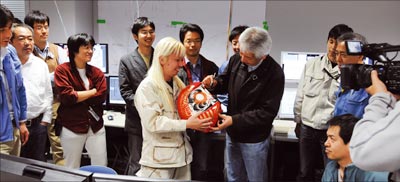
Image credit: KEK.
On 23 April, the Tokai-to-Kamioka (T2K) long-baseline neutrino oscillation experiment confirmed the first production of the neutrino beam by observing the muons produced by the proton beam in the neutrino facility at the Japan Proton Accelerator Complex (J-PARC).
The T2K experiment uses a high-intensity proton beam at J-PARC at Tokai to generate neutrinos that will travel 295 km to the 50 kt water Cherenkov detector, Super-Kamiokande, which is located about 1000 m underground in the Kamioka mine (CERN Courier July/August 2008 p19). The experiment follows in the footsteps of KEK-to-Kamioka (K2K), which generated muon neutrinos at the12 GeV proton synchrotron at KEK.
With the beam generated at the J-PARC facility, T2K will have a muon-neutrino beam 100 times more intense than in K2K. This should allow the experimenters to measure θ13, the smallest and least well known of the angles in the neutrino mixing matrix, which underlies the explanation of neutrino oscillations. Experiments with atmospheric neutrinos have found the mixing angle θ23 to be near to its maximal value of 45°, while the long-standing solar neutrino problem has been solved by neutrino oscillations with a large value for θ12 (Borexino homes in on neutrino oscillations).








